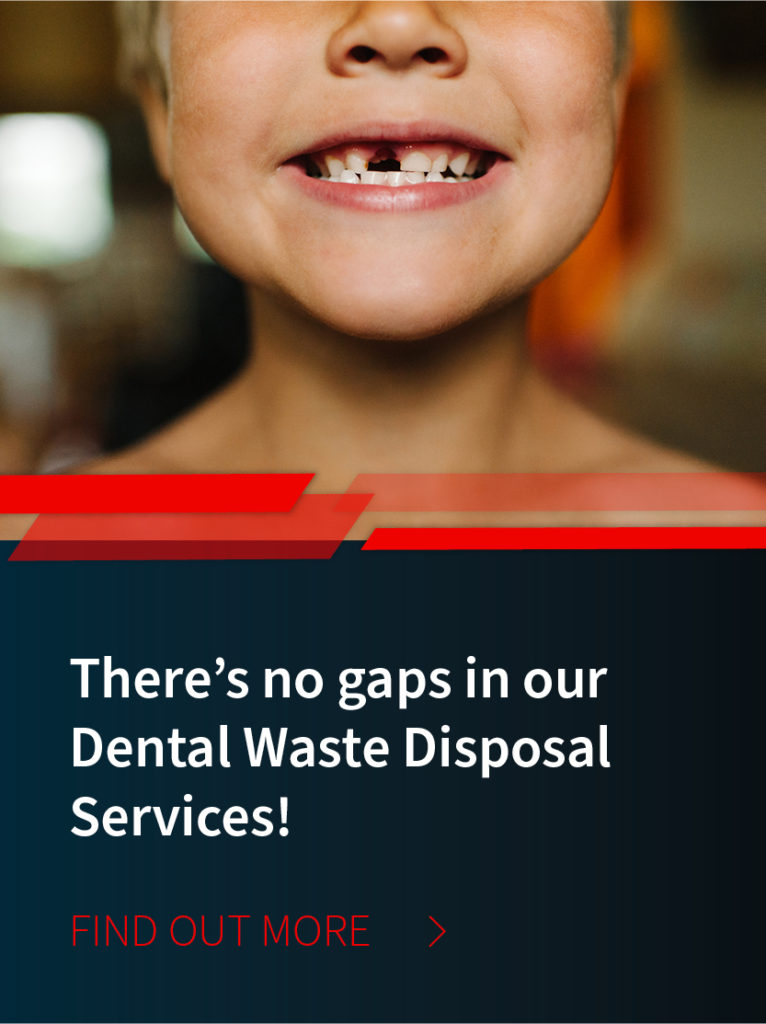
/ IN THIS BLOG
01 / Dental amalgams as hazardous waste
By far the most ubiquitous hazardous waste emanating from dental offices is dental amalgam. Why is it a problem?
The amalgam that comprises dental fillings is approximately 50 percent liquid mercury “amalgamated” to powdered silver, tin, and copper. The mercury is there as a binder to create a durable alloy that can withstand the complicated and formidable dynamics of chewing.
When old fillings are drilled, spent amalgam enters the chairside cuspidor. It’s the same for new fillings, when patients have residual amalgam evacuated from their mouths with suction.
As there are approximately 103,000 dental offices in the US that use amalgam, the EPA estimates that—prior to legislation—dental clinics had been discharging approximately 5.1 tons of mercury yearly into municipal sewer systems.
Nearly all that mercury was remaining in the post-treatment wastewater sludge, which is typically incinerated. Thus, it was emitting mercury vapor into the environment, which is virtually the only form in which mercury is poisonous.
Sludge that isn’t incinerated is typically placed in landfills or applied to farmland as fertilizer, which also can release mercury vapor into the environment, depending on local circumstances and conditions.
For these reasons, the EPA mandated that all existing dental practices have amalgam separators installed on dental engines by July 14, 2020, which capture any-and-all solids before they can reach the sewer, dropping them into a canister. Then, the collected amalgam must be removed from the canister and properly disposed of by a duly licensed hazardous waste removal company.
02 / X-ray and lead-containing dental wastes
X-ray waste includes processing chemicals, acid etch, disinfectants, monomers, and x-ray film.
Due to its high silver content, used X-ray fixer cannot be disposed of down the drain.
X-ray packets and lead aprons contain lead foil, which can contaminate soil and groundwater if sent to landfills. Thus, lead disposal requires hazardous waste management.
03 / Dental medical waste disposal
Although there are “guidelines,” there is no explicit definition of medical waste in federal law. Instead, it’s left to the individual states to determine which wastes are regulated or require special handling.
In general, most state laws require regulated medical waste (RMW) to be rendered non-infectious before it can be disposed of as solid waste. Thus, you’re going to have to transport any RMW offsite to a waste management facility; and thereby need access to both a transporter and a treatment company, each licensed or “permitted” to handle RMW.
- Pathological waste. E.g., teeth, tissues, organs, body parts, and body fluids removed during surgery and autopsy
- Human blood and blood products. E.g., waste blood, serum, plasma, and blood products
- Microbiological wastes. Cultures and stocks of infectious agents such as laboratory specimens (E.g. culture dishes; transfer, inoculation, and/or mixing devices; discarded live and attenuated vaccines; etc.)
- Contaminated sharps. E.g., contaminated hypodermic needles, syringes, scalpel blades, pipettes, and broken glass
- Isolation waste. Wastes generated from patients who are isolated to protect others from a communicable disease
- Contaminated animal wastes. (E.g., carcasses, body parts, and bedding from animals intentionally exposed to pathogens in research, biologicals production, or drug tests
04 / Dental sharps disposal
A subcategory of medical waste, a “sharp” is any device having a point or edge that can puncture or incise skin—whether by design or accident. These include needles, syringes, lancets, auto-injectors, infusion sets, and connection needles/sets.
According to OSHA, improper sharps disposal is a significant cause of injury in the workplace, usually due to bad or problematic practices, not enough sharps containers in a given area, overfilled containers, or using the wrong sharps container for a given device.
Thereby, all sharps must be disposed of into a purposed-designed container immediately after use. This is to reduce the primary risk of accidental cuts and punctures, as well as the secondary risk of spreading disease by way of those cuts and punctures.
You can learn more about safely disposing sharps here.
05 / Dental pharmaceutical waste disposal
There are two kinds of hazardous waste according to the EPA: (1) Characteristic and (2) Listed.
- Characteristic hazardous wastes possess noxious “characteristics” such as:
Ignitability—they catch fire under certain conditions, posing obvious transport and storage dangers
Corrosiveness—they can disintegrate metals and therefore require storage vessels constructed of (or lined with) anticorrosive materials
Toxicity—they are harmful or fatal to humans and/or local biota when ingested or absorbed, or can leach into soil or groundwater
Reactivity—otherwise benign chemicals might become flammable, corrosive, unstable, or toxic when mixed with others
- Listed hazardous wastes don’t have such intrinsically noxious “characteristics” in and of themselves. Instead, they require hazardous waste disposal because they’re offshoots of manufacturing practices that typically produce a hazardous waste. The EPA keeps two lists of these chemicals, all of them considered a hazardous waste in both their pure and commercial-grade formulations. These are the “P” and “U” lists and contain such everyday meds as warfarin, cyclophosphamide, and lindane.
Pharmaceuticals that are a listed or characteristic hazardous waste must be disposed of as such—not as medical or solid waste.
Typical pharmaceutical wastes include expired drugs, open drugs that cannot be used, drugs intended for disposal, waste materials containing excess drugs, contaminated absorbents, and more. (E.g., unused anesthetic carpules or used ones with more than 3% anesthetic residue.)
Pharmaceutical wastes must be disposed of in labeled containers and kept separate from traditional trash, as it must be disposed of differently.
You shouldn’t have individual employees making off-the-cuff decisions about what to do with pharmaceutical wastes that they might incidentally encounter. You need a system. And once you develop one and have everyone trained in its execution, the odds get better that costly mistakes will be avoided: many of them litigable or even criminal.
Typical handling errors for discarded pharmaceuticals include:
- Untrained personnel pouring unused IV or other fluid compounds down drains,.
- P- or U-Listed wastes being mixed with non-hazardous wastes and then improperly discarded
- More than trace amounts of P- or U-listed substance remain in discarded vials, IV's, or syringes found in your yellow chemo-waste containers
- Pharmaceutical waste being placed in sharps containers
06 / Miscellaneous dental wastes
These include obvious materials such as chemicals, disinfectants, and sterilizing agents. But there are less intuitive things that must be considered, such as obsolete electronics, spent fluorescent tubes, dead batteries, and more.
07 / The upshot on dental wastes
Trust MCF to manage every aspect your dental hazardous waste responsibilities.
Over the course of 30-plus years serving medically related companies of all sizes, we’re dedicated to helping our dental clients overcome the unique challenges posed by federal, state, and local environmental regulations pertinent to their operations.
Our systems and processes are purpose-designed to help your dental facility meet the hazardous waste disposal requirements specific to a modern dental practice, with minimal intrusion into your day-to-day clinical operations—allowing you to concentrate on providing quality dental care to your patients.
We never broker or subcontract any portion of your hazardous waste disposal to another company. Doing so invites lapses in compliance—inadvertent or otherwise—which is why we manage the process from start to finish on your behalf.
For more information, contact us today. Or phone 866.315.8116
And thank you for reading our blog!
Robert Losurdo
President, COO








